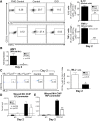The Histone Methyltransferase MLL1 Directs Macrophage-Mediated Inflammation in Wound Healing and Is Altered in a Murine Model of Obesity and Type 2 Diabetes
- PMID: 28663191
- PMCID: PMC5566299
- DOI: 10.2337/db17-0194
The Histone Methyltransferase MLL1 Directs Macrophage-Mediated Inflammation in Wound Healing and Is Altered in a Murine Model of Obesity and Type 2 Diabetes
Abstract
Macrophages are critical for the initiation and resolution of the inflammatory phase of wound repair. In diabetes, macrophages display a prolonged inflammatory phenotype in late wound healing. Mixed-lineage leukemia-1 (MLL1) has been shown to direct gene expression by regulating nuclear factor-κB (NF-κB)-mediated inflammatory gene transcription. Thus, we hypothesized that MLL1 influences macrophage-mediated inflammation in wound repair. We used a myeloid-specific Mll1 knockout (Mll1f/fLyz2Cre+ ) to determine the function of MLL1 in wound healing. Mll1f/fLyz2Cre+ mice display delayed wound healing and decreased wound macrophage inflammatory cytokine production compared with control animals. Furthermore, wound macrophages from Mll1f/fLyz2Cre+ mice demonstrated decreased histone H3 lysine 4 trimethylation (H3K4me3) (activation mark) at NF-κB binding sites on inflammatory gene promoters. Of note, early wound macrophages from prediabetic mice displayed similarly decreased MLL1, H3K4me3 at inflammatory gene promoters, and inflammatory cytokines compared with controls. Late wound macrophages from prediabetic mice demonstrated an increase in MLL1, H3K4me3 at inflammatory gene promoters, and inflammatory cytokines. Prediabetic macrophages treated with an MLL1 inhibitor demonstrated reduced inflammation. Finally, monocytes from patients with type 2 diabetes had increased Mll1 compared with control subjects without diabetes. These results define an important role for MLL1 in regulating macrophage-mediated inflammation in wound repair and identify a potential target for the treatment of chronic inflammation in diabetic wounds.
© 2017 by the American Diabetes Association.
Figures








Similar articles
-
Histone Methylation Directs Myeloid TLR4 Expression and Regulates Wound Healing following Cutaneous Tissue Injury.J Immunol. 2019 Mar 15;202(6):1777-1785. doi: 10.4049/jimmunol.1801258. Epub 2019 Feb 1. J Immunol. 2019. PMID: 30710046 Free PMC article.
-
Epigenetic Regulation of TLR4 in Diabetic Macrophages Modulates Immunometabolism and Wound Repair.J Immunol. 2020 May 1;204(9):2503-2513. doi: 10.4049/jimmunol.1901263. Epub 2020 Mar 23. J Immunol. 2020. PMID: 32205424 Free PMC article.
-
The STAT4/MLL1 Epigenetic Axis Regulates the Antimicrobial Functions of Murine Macrophages.J Immunol. 2017 Sep 1;199(5):1865-1874. doi: 10.4049/jimmunol.1601272. Epub 2017 Jul 21. J Immunol. 2017. PMID: 28733487 Free PMC article.
-
The many facets of MLL1 regulation.Biopolymers. 2013 Feb;99(2):136-45. doi: 10.1002/bip.22126. Biopolymers. 2013. PMID: 23175388 Review.
-
Histone modifications and their roles in macrophage-mediated inflammation: a new target for diabetic wound healing.Front Immunol. 2024 Aug 20;15:1450440. doi: 10.3389/fimmu.2024.1450440. eCollection 2024. Front Immunol. 2024. PMID: 39229271 Free PMC article. Review.
Cited by
-
Macrophage-Mediated Inflammation in Skin Wound Healing.Cells. 2022 Sep 21;11(19):2953. doi: 10.3390/cells11192953. Cells. 2022. PMID: 36230913 Free PMC article. Review.
-
Murine macrophage chemokine receptor CCR2 plays a crucial role in macrophage recruitment and regulated inflammation in wound healing.Eur J Immunol. 2018 Sep;48(9):1445-1455. doi: 10.1002/eji.201747400. Epub 2018 Jun 26. Eur J Immunol. 2018. PMID: 29879295 Free PMC article.
-
Epigenetic regulatory mechanism of macrophage polarization in diabetic wound healing (Review).Mol Med Rep. 2025 Jan;31(1):2. doi: 10.3892/mmr.2024.13367. Epub 2024 Oct 18. Mol Med Rep. 2025. PMID: 39422035 Free PMC article. Review.
-
The STAT3/SETDB2 axis dictates NF-κB-mediated inflammation in macrophages during wound repair.JCI Insight. 2024 Oct 22;9(20):e179017. doi: 10.1172/jci.insight.179017. JCI Insight. 2024. PMID: 39435663 Free PMC article.
-
Adipose-Derived Mesenchymal Stem Cells Accelerate Diabetic Foot Ulcer Healing by Promoting Macrophage M2 Polarization Through Downregulation of EREG and CSTA.J Inflamm Res. 2025 Jun 12;18:7749-7768. doi: 10.2147/JIR.S519713. eCollection 2025. J Inflamm Res. 2025. PMID: 40529896 Free PMC article.
References
-
- Faglia E, Favales F, Morabito A. New ulceration, new major amputation, and survival rates in diabetic subjects hospitalized for foot ulceration from 1990 to 1993: a 6.5-year follow-up. Diabetes Care 2001;24:78–83 - PubMed
-
- Izumi Y, Satterfield K, Lee S, Harkless LB, Lavery LA. Mortality of first-time amputees in diabetics: a 10-year observation. Diabetes Res Clin Pract 2009;83:126–131 - PubMed
-
- Mirza R, Koh TJ. Dysregulation of monocyte/macrophage phenotype in wounds of diabetic mice. Cytokine 2011;56:256–264 - PubMed
-
- Falanga V. Wound healing and its impairment in the diabetic foot. Lancet 2005;366:1736–1743 - PubMed
MeSH terms
Substances
Grants and funding
LinkOut - more resources
Full Text Sources
Other Literature Sources
Medical
Molecular Biology Databases

